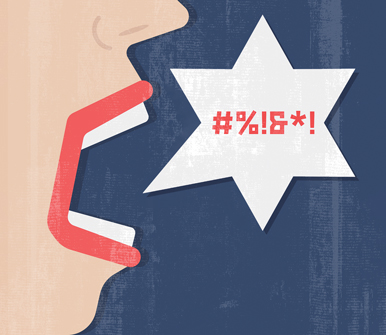
Antisemitism has been part of the American experience since the first Jews landed in what is now New York City 370 years ago. In 2023, antisemitic incidents of assault, harassment, and vandalism surged a record 140 percent. Nearly 8,900 acts of hate—24 per day—were perpetrated against members of the Jewish community, more than in the last three years combined. Pamela Nadell, author of the forthcoming Antisemitism, an American Tradition, says that to understand this unprecedented—and unsettling—moment, we must examine the history of what has been called “the longest hatred.”
Q. Historians have called the period between World Wars I and II the “high tide of antisemitism in America.” How would you describe the climate now?
A. Antisemitism declined in the US from the mid-’60s to the mid-’90s, and it really flattened out from the end of the twentieth century until 2016. Then it started to rise again because the rhetoric during and after the election included attacks on immigrants and Muslims—and, eventually, Jews. It may not have started with the Jews, but it’s always going to hit the Jews, especially because of the great replacement theory.
Then we saw Charlottesville in 2017, Pittsburgh in 2018, and the Poway shooting a year later. I think we are actually living through the high tide of American antisemitism now and that future historians will have to rename the earlier era. It seems like we are in a moment in which American Jews feel under siege in the same way they did in the 1920s through the early ’50s.
Q. Why is it important to understand the history of antisemitism in our country?
A. I don’t believe that history repeats itself, but I know it informs our understanding of the present. It’s crucial to understand the longevity of antisemitism in the US. It’s different than antisemitism in Europe, which took the form of genocide. But that doesn’t mean that the antisemitism that occurred in America—starting in 1654, when Governor Peter Stuyvesant tried to expel the first 23 Jews from New Amsterdam—is inconsequential. It has actually been very consequential, as we’re seeing now.
This is where history is important. Most people don’t know that for 91 weeks, Henry Ford published a series of articles decrying the Jews in his newspaper, the Dearborn Independent. They don’t understand that the way [some on the far right] decry George Soros for manipulating the world is the same way that the Rothschilds were decried for manipulating the world. If you don’t understand antisemitism in the past, how can you possibly understand that people are using it in exactly the same way today?
Q. What makes you optimistic about Jewish life in America?
A. I’m not optimistic, I’m hopeful. I’m hopeful that we can do what needs to be done to tamp down on the acceptability of antisemitism from virtually every sector of American life.
That’s what happened in the ’40s and ’50s—there were social and cultural forces at work that made antisemitism unacceptable. It wasn’t only the Holocaust; people worked, organizations worked, authors worked to make antisemitism a cause. We need to do that again, and it needs to happen at the very top of our society, from leaders in government, industry, and higher education. They need to set the tone, and my hope is that it will filter down.